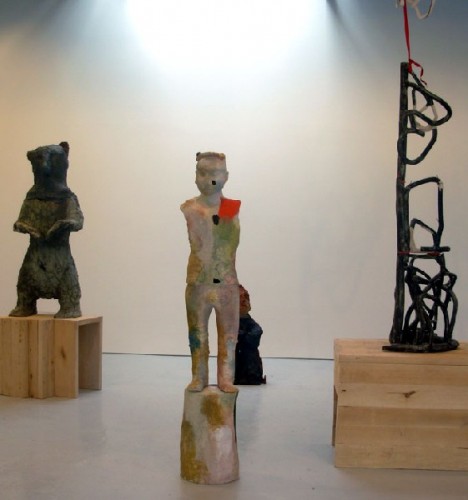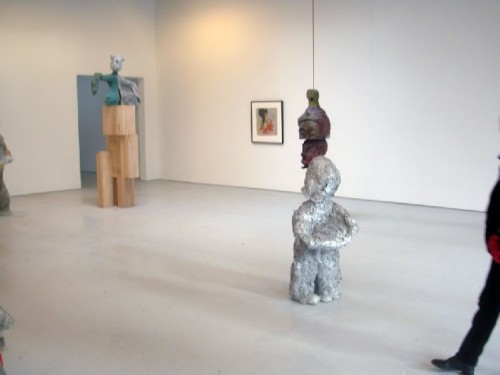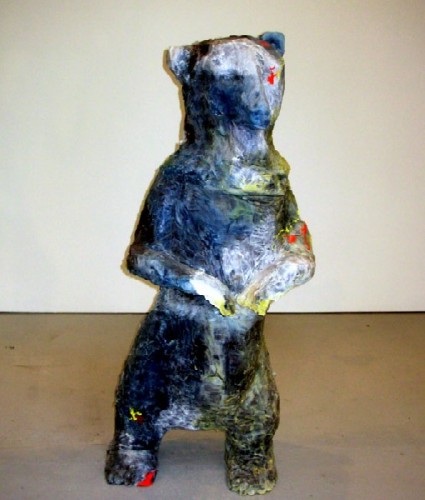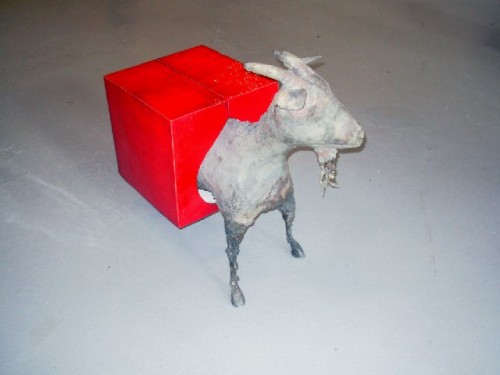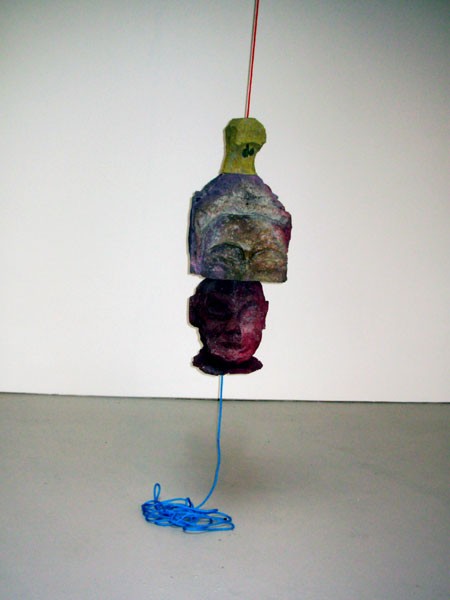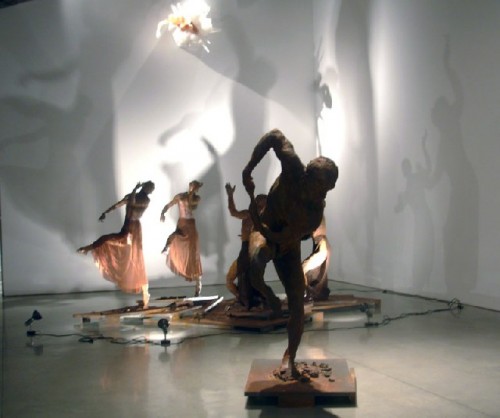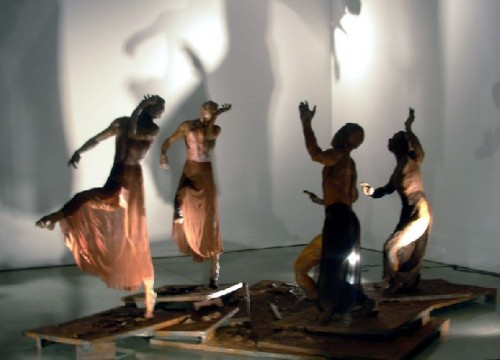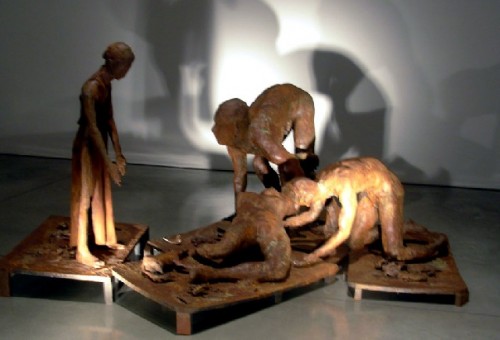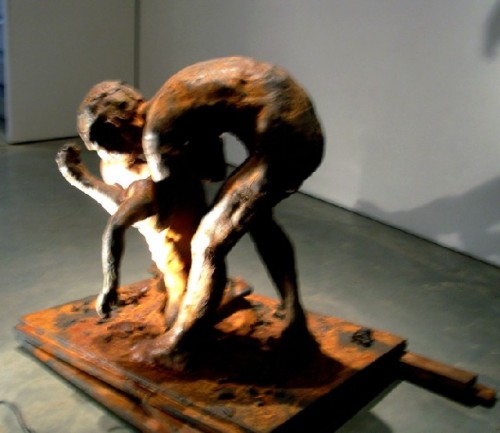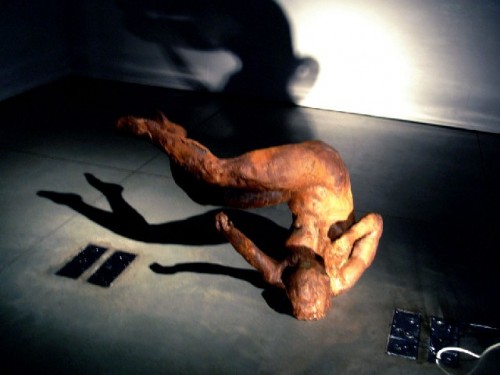Sculpture by Anne Chu and Eric Fischl in Chelsea
Exhibitions at 303 Gallery and Mary Boone
By: Charles Giuliano - Dec 15, 2008
Anne Chu
303 Gallery
547 West 21st Street
New York, New York
Through December 20
Eric Fischl
Mary Boone Gallery
541 West 24th Street
New York, New York
Through December 20
The exhibitions of sculpture by Ann Chu, at 303 Gallery, and Eric Fischl, at Mary Boone, proved to be enticing and insightful but for different reasons. The works by Chu which are quirky, diverse, and eccentric are also paradigmatic of the eclecticism of materials and figuration that are endemic to contemporary art. While the Fischl, life size figurative pieces in bronze, though competent, are reactionary and academic. In that sense, the exhibitions considered in tandem represent the book ends of critical thinking about approaches to solids and the figure.
While the figure, animal and human, is a locus for Chu it is presented with an ephemeral whimsy. There is a commonality of approach but also diversity to the extent that no two works seem alike. Each piece springs from a separate inspiration or inclination. There is a deliberate crudeness that makes craft and technique a lesser consideration. A roughness of texture and surface plays down the notions of skill in fabrication in favor of a primacy of idea and the non slick. But there is far too much sophistication and intentionality to suggest that this is innocent, outsider work. The artist appears to prefer to tie the adroit arm of aesthetics behind her back as she thrust about for a primal emotive gesture.
Given her surname it is not surprising to find references to the Oriental. There is a Buddha's head suspended in space. In a bell, or gong like configuration. But this notion is briefly interjected. Turning to another work we find a rough textured, painted, standing bear. How does one idea conflate with another? Yet again we encounter, by looking down, a goat whose hind quarters morf into a painted cube.
Walking through Chu's installation each encounter with a specific work evokes yet another response and idea. The parts remain separate and refuse to gather into a whole. And yet, for all of the diversity, there is a cohesive look and persona at play. But encountering a single work in a group show at some point in the future it would be challenging to identify work by this artist. Seen out of context just what is it about an individual work that evokes the notion that is unique to this artist? It is precisely this eclectic refusal to find a single identity or theme to the work which may indeed reflect the edgy matrix of the current zeitgeist. This may also be reflective of generational apathesia and disassociation. Perhaps it resonates more with a younger viewer and its locus in the notion of against interpretation. Which represents two or three jumps on from the Lost Generation. Perhaps it is a matter of just Being There.
If working through an exhibition by Chu represents a challenge and conundrum the Fischl show deflates by being far too obviously accessible in its histrionic theatricality. One is tempted to say that Rodin is the source of inspiration for this suite of ersatz romantic, figurative bronzes, but Camille Claudel is perhaps closer to the mark.
Were it not that Eric Fischl, an established figurative painter, is showing this rather mediocre sculpture at the high profile, Mary Boone Gallery, there would be little or no reason to discuss it. Not that it is really bad. What is most concerning is that it is accomplished enough to attract our attention. But there is nowhere to go from there.
The vulgarity and mediocrity of the work is further exacerbated by its artsy, theatrical lighting. The gallery is dark other than spots that are positioned to evoke a drama that is not inherent in the work itself. There are groupings including several women dancers with outstretched legs over which are draped transparent skirts. Other figures grope, twist, and turn with an anguish that evokes Rodin, and Claudel, at their most intensely romantic and melodramatic. Truth is Mr. Fischl, that we are all doomed to hell, or that greater hell, heaven, so why does he go to such trouble to remind us of the grim and inevitable.
While the forms are soft, buttery, and true to the manipulation of additive materials the patina is rough textured to the point of being gross. Of course it is this brutality and abuse of the surface that makes them contemporary. But compare their rough and abrasive textures to those of Giacometti. He shared the Post War aesthetics of Art Brut with Dubuffet but compared to the ham fisted angst of Fischl their brutality was poetic and spiritual. Like the figures he evokes in all of their contortions Fischl is just a lost soul. Won't Get Fooled Again.

